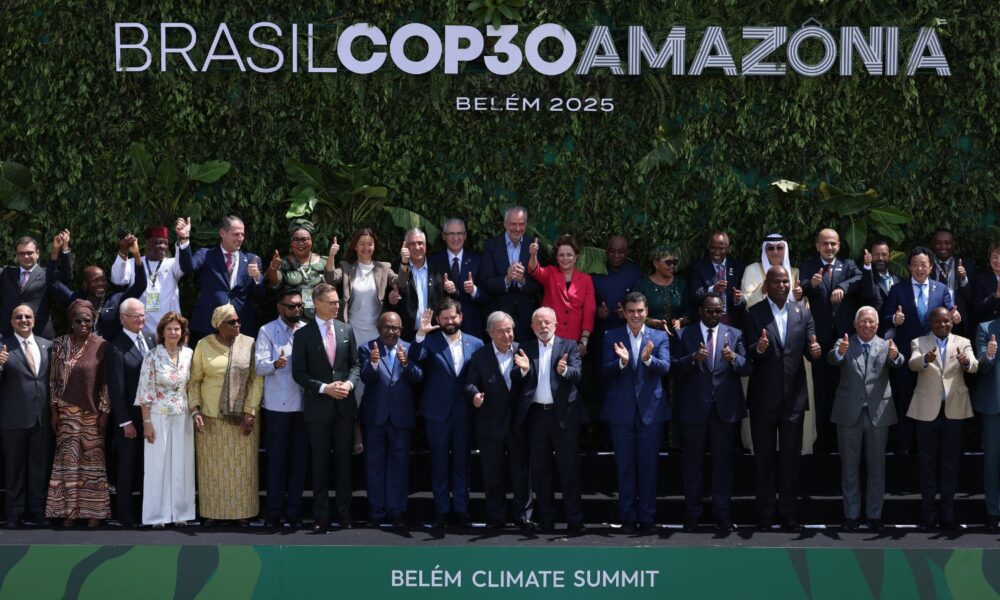It’s been a busy week here in Belém, Brazil, as week 1 of COP30, the annual UN climate talks, draws to a close. The negotiations are at a stage now where glimmers of progress are emerging, but there’s a long way to go to land a bold consensus here over the next week.
Going into COP30, the Leader’s Summit and the opening plenary set a tone of urgency and constructive engagement. In a powerful speech President Lula called this “the COP of truth.” UN Climate Change Executive Secretary Simon Stiell urged countries to take bold action together because “While climate disasters decimate the lives of millions, when we already have the solutions, this will never, ever be forgiven.”
So where do things stand at COP30? Here are some of the key issues I’m watching:
- No fight over the COP30 agenda, but will that harmony last? COP30 President André Corrêa do Lago deftly managed to avoid a fight over the COP agenda, which could have stalled proceedings straight out of the gate. Nations had requested additions to the provisional agenda, a common occurrence at COPs. Instead, he moved those issues into parallel consultations on four key topics. An initial stocktake plenary on Wednesday ended in less that 5 minutes, with the President indicating that negotiators need more time to make progress. Another stocktake plenary is slated for Saturday. This one will be a critical check on whether countries are actually able to close gaps and are moving toward areas of agreement. Pressure is building for some breakthroughs, otherwise the agenda fight may not have been avoided but rather punted further into the COP proceedings.
- How will the ambition gap in NDCs be addressed? Coming into COP30, multiple reports—including the NDC Synthesis Report and the UNEP Emissions Gap Report—showed that countries’ collective emission reduction commitments were well short of what’s necessary to meet the Paris Agreement goals. This COP must deliver an outcome that clearly recognizes that shortfall and creates an actionable process for countries, on a voluntary basis (as always, under the Paris Agreement), to revisit and revise their NDCs rather than waiting another five years for greater ambition. The world is on track to breach 1.5°C by the early 2030s—there is no time to waste.
- Will there be a strong agreement on adaptation at COP30? Adaptation is one of the burning issues for climate-vulnerable, low-income countries that has long received short shift at the annual climate talks. As extreme climate impacts worsen, they are taking an especially harsh toll in places where people have fewer resources to begin with, setting back economic growth and poverty alleviation efforts. Funding for adaptation has been significantly lagging, as the recent Adaptation Gap report showed. We need a clear outcome on the Global Goal on Adaptation that doesn’t just address metrics, but also provides a tangible path forward on closing the adaptation finance gap. For many countries in the Global South, this will be the key issue to unlock progress in other areas of the negotiations.
- Will there be a just transition package that includes a fast, fair fossil fuel phaseout? The Brazilian government has proposed a road map for a fossil fuel phaseout, which now has the support of over 60 countries. Colombia, which has signed on to the fossil fuel non-proliferation treaty, has also put forward a declaration on a fossil fuel phaseout. These efforts are well aligned and complementary, with the overall frame of “a just transition away from fossil fuels” gathering momentum here at COP30. A fast, fair fossil fuel phaseout is a crucial component of what it will take to close the NDC ambition gap.
It will require finance for developing countries to accelerate access to affordable clean energy, assistance for workers currently dependent on fossil fuels, and support for communities suffering from fossil fuel pollution. Getting these details right is very important, as the Belem Action Mechanism describes—because how we make this transition away from fossil fuels to clean energy will determine whether the transition is going to serve the needs of people, or whether this is, once more, going to be controlled by the fossil fuel industry as they try to extract as much profit as they can on the way out. Of course, securing an ambitious outcome will mean standing up to fossil fuel interests that are attending these COPs in ever larger numbers. - How will the long-festering climate finance issue be addressed? Last year’s COP29 at Baku, which was focused on finance, ended on a sour note with an appallingly low finance figure agreed. Earlier this month, the COP Presidencies of Azerbaijan and Brazil released the Baku to Belem Roadmap outlining a path to meet a climate finance goal of at least $1.3 trillion by 2035. This week, the Independent High Level Expert Group on Climate Finance—which has supported the finance negotiations since 2021—delivered its 4th report on climate finance, focused on pathways to deliver on that roadmap. This funding would come from a mix of domestic sources, public finance (from multilateral, bilateral and concessional sources of funding), and private finance.
The funding is needed for a clean energy transition; adaptation and resilience measures; loss and damage; conserving forests, oceans and biodiversity; and for a just transition away from fossil fuels in developing countries. Of course, it will take concerted commitments and actions from countries, multilateral development banks and private sector actors to deliver on this necessary scale of funding. However, richer nations have repeatedly shirked their responsibilities despite being the primary contributors to global warming emissions. Pivoting to a primary dependence on uncertain private sector funds or loans leaves lower income nations exposed to further economic risks and debts, rather than delivering the climate justice they deserve. Will countries take forward concrete proposals and ideas to enhance the delivery of high-quality finance—or will they fall short again, which would further erode trust between developed and developing countries? - The Fund for Responding to Loss and Damage (FRLD) launches call for proposals. Earlier this week, the FRLD launched its first-ever call for proposals for funding requests to address loss and damage, a welcome and long-awaited step in operationalizing the Fund. The recent devastating climate-change-fueled typhoons and hurricanes harming people in the Philippines, Vietnam, Jamaica, Cuba, and Haiti are just the latest examples underscoring the critical need for rapidly increasing this funding in a fair and transparent way. Breaching 1.5°C has enormous consequences for climate Loss and Damage, as poorer nations on the frontlines of the climate crisis endure a steepening toll resulting primarily from richer nations’ failure to adequately curtail their heat-trapping emissions. The initial $250 million in funds currently available are nowhere near enough, and countries most responsible for the climate crisis must lead the scaling up of funding for loss and damage.
- Will the Tropical Forest Forever Facility (TFFF), launched at COP30, be a success? This is a key initiative championed by Brazil though. funding support for it has been underwhelming thus far. And it remains to be seen if the TFFF can be structured in a way that delivers durable protections for tropical forests and biodiversity while prioritizing the rights of Indigenous people who live in these forests and have long defended them.
More sobering data on global CO2 emissions
At COP30, scientists presented new data from the Global Carbon Project released yesterday, which shows global carbon emissions continuing to rise, hitting a record high in 2025. According to the report, atmospheric CO2 concentrations will hit 425.7 ppm in 2025, which is 52% above pre-industrial levels. The most sobering data are related to the rapidly dwindling remaining carbon budget—the amount of carbon emissions the world can still emit to stay below specific temperature thresholds. According to the Global Carbon Project: The remaining carbon budget to limit global warming to 1.5°C , 1.7°C and 2°C is 170 GtCO2, 525 GtCO2, and 1055 GtCO2 respectively, equivalent to 4, 12 and 25 years from 2026. A total of 2770 GtCO2 has been emitted since 1850.

Source: IPCC AR6 WG1; Forster et al., 2023; Friedlingstein et al 2025; Global Carbon Project 2025
The United States is still here, even if the White House is missing in action
The Trump administration did not send an official delegation to COP30, the first time this has happened for the United States. No surprise, given the administration’s deep hostility toward climate science, clean energy policies and multilateral diplomacy. And frankly, their presence here would just have been destructive anyway—so perhaps better not to have them here.
In contrast, it has been incredibly heartening to see California Governor Newsom, US Senator Whitehouse, and many more representatives from US states, cities, Tribal nations, educational institutions, and businesses here at COP30, showing the world that many people in the US are still very committed to climate action. These forward-looking leaders know that addressing climate change is in our nation’s self-interest, in addition to being in the collective global interest. People in the US too are feeling the pain of the rapidly worsening climate crisis and are eager to reap the health and economic benefits of a clean energy transition. As these subnational efforts gather momentum, it’ll be important to remember that the US also has a responsibility to meet its climate finance commitments to lower income nations, even as it pursues efforts at home.
Looking ahead to week two
Negotiations on Saturday, including the plenary stocktake, will be key barometers of progress as negotiators head into week two and country ministers arrive in Brazil. We should soon start to see the outlines of a ‘COP package,’ if all goes well (and that’s always a big ‘if’ at this stage of COP). Later next week, we will also hear whether COP31 will be held in Australia or Turkey (or some other wild card country?) Both nations are vying for the chance to host next year’s COP.
On Saturday, there will also be a huge Global Day of Action for Climate Justice with a massive march here in the streets of Belém and in cities around the world. Public pressure and calls to action from people protesting in the streets are vital to remind negotiators of the high stakes for the world for this COP to deliver an ambitious outcome!
Stay tuned for more from our team participating in COP30!

